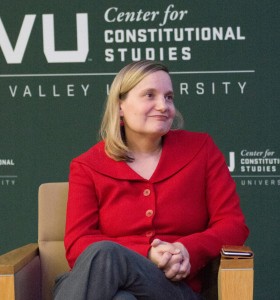
BYU political science professor Quin Monson and Notre Dame political science chairman David Campbell have teamed up to investigate Mormon millennial political behaviors in their co-authored book, “Seeking the Promise Land: Mormons and American Politics.”
Monson and Campbell presented their work at Utah Valley University’s 2016 Mormons Studies Conference titled “Mormonism and the Art of Boundary Maintenance.”
“What the whole thing really boils down to is a question about religious pluralism, and what it means to be a truly religiously pluralist society,” Campbell said. “I would argue what we see among Mormons is a microcosm of the American story of religion.”
Both Monson and Campbell conducted social science research in order to examine the political attitudes, actions and perceptions of members of the Church of Jesus Christ of Latter-day Saints, as well as perceptions that other groups hold toward Mormons.
Campbell said the book reflects the struggles religious groups face in navigating an increasingly secular world and their use of political action.
Monson opened the discussion by recounting the formative ideas behind the book’s primary theory, something the two political scientists term “Sacred Tabernacle.”
The theory holds that political and religious attitudes make Mormons culturally distinctive from other religious and cultural groups. Attitudes further vary within the Mormon group based on factors such as activity in the church, deference to authority and level of insularity and identity.
This variation extends to Mormons both in and out of Utah. The only measurable differences between Mormons in Utah and outside of Utah was the measure of insularity, or likelihood they have Mormon associates or family members.
Further, Mormons, which they called a “quasi-ethnic group,” are typically conservative and Republican across the nation.
Monson explained that the idea of the “Sacred Tabernacle” was an amalgamation of two other theories that explains that Mormonism provides both an emphasis on individual worship and identity and on a strong sense of community.
Campbell said this “Sacred Tabernacle” theory helped to explain the perception of Mormons in the United States. He said apart from atheists and Muslims, Mormons are the least liked religious group in the nation, respectively.
Mormonism is strongly based in an “us against the world” mentality and often employs militaristic imagery to describe the experience or the ideal action of church members, according to Campbell. This creates two boundaries that Mormons maintain: boundaries between other religions and between the secular world, further driving insularity.
However, he said Mormon leadership has called for a tolerance of others and that policy positions on things like abortion, refugees and immigration steer a more palatable and moderate direction for members.
“So what it boils down to is everyone hates Mormons, Mormons love everyone more than everyone else and Mormons really love themselves,” Campbell said.
The data presented indicated that Mormons have the highest opinion of their own group than does any other group.
Further discussion was moderated by Religion News Service senior columnist Jana Riess who filled in for New York Post columnist Naomi Riley after Riley was delayed in transit.
Riess asked a question about Mormon millennials and how they factored in politically.
Both Monson and Campbell responded that Mormon millennials are more Republican than their forebearers, sharply contrasting the very heavy Democrat national millennial demographic.
Campbell said millennials’ parents and grandparents were more likely to be Democrats because there was a time when some General Authorities were Democrats. Millennials have come of age in a time where Mormonism shifted from a relative partisan balance to the strong Republican leanings.




